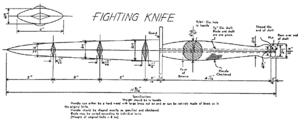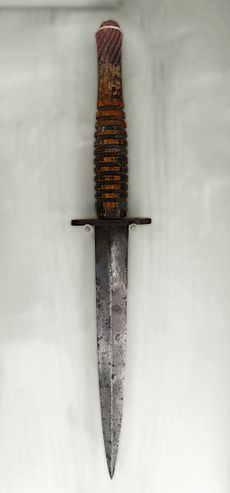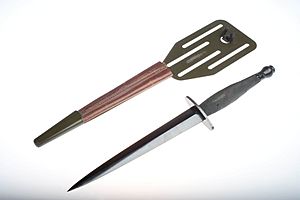Fairbairn–Sykes fighting knife facts for kids
Quick facts for kids Fairbairn–Sykes fighting knife |
|
|---|---|

F-S fighting knife – ring grip pattern
|
|
| Type | Dagger |
| Place of origin | United Kingdom |
| Service history | |
| In service | 1941–present |
| Used by | See Users |
| Wars | World War II – present |
| Production history | |
| Designer | William Ewart Fairbairn and Eric Anthony Sykes |
| Designed | 1941 |
| Manufacturer | Wilkinson Sword Ltd |
| Produced | 1941 |
| Specifications | |
| Length | 11.5 inches (29 cm) |
| Blade length | 7 inches (18 cm) |
|
|
|
| Blade type | Dagger |
| Hilt type | Metal |
| Scabbard/sheath | Metal |
| Head type | Metal |
| Haft type | Metal |
The Fairbairn–Sykes fighting knife is a special kind of dagger with two sharp edges. It was created by William Ewart Fairbairn and Eric Anthony Sykes in Shanghai. They got the idea for this knife while working for the police in China before World War II.
This knife became very famous during World War II. It was given to brave soldiers like the British Commandos, Airborne Forces, and the SAS. Many units used it, especially during the Normandy landings in June 1944. The F-S knife has a very sharp, pointed blade, which makes it great for thrusting. However, it can also be used for cutting if its edges are sharpened. The Wilkinson Sword Company made these knives, with small changes to the handle over time.
Contents
History of the F-S Knife
The F-S knife is well-known for its use by British commandos and special forces in the United States, like the Office of Strategic Services (OSS) and Marine Raiders. It is even part of the symbols for groups like the British 3 Commando Brigade and the United States Army Rangers. Many of these knives were used by Canadian soldiers during D-Day. There's even a solid gold F-S knife at the commandos' memorial in Westminster Abbey.
The very first 50 F-S fighting knives were made in January 1941 by Wilkinson Sword Ltd. Fairbairn and Sykes visited the factory in November 1940 to share their ideas for this new fighting knife.
Soon after, a larger order for 1,500 knives was placed. Then, in 1941, an even bigger order for 38,000 knives was made. By 1943, many different companies were making the knife. Even today, a government standard from 1949 still guides how these knives are made. In December 2019, a soldier from the SBS used an F-S knife during a fight in Afghanistan, showing it's still in use.
How the F-S Knife Was Designed
The F-S fighting knife was made for surprise attacks and close-up fighting. Its thin blade can easily go through tough materials. The handle is shaped like a vase, which helps you hold it firmly. William Fairbairn explained his ideas for the knife in his book Get Tough! (1942). He said that a knife should feel balanced and have a very sharp point and good cutting edges. This helps make sure that if someone is hurt, the injury is serious.
The Fairbairn-Sykes knife was made in a few different versions. The original knife from Shanghai had a blade about 5.5 in (14 cm) long.
- First-pattern knives had a 6.5 in (17 cm) blade.
- Second-pattern knives had a slightly longer blade, almost 7 in (18 cm). They also had a special bumpy (knurled) grip and a round end.
- Third-pattern knives also had a seven-inch blade, but the handle was changed to have rings. This ringed handle was easier to make.
The blade length was chosen to be long enough to go through thick clothing, like the heavy coats worn by Soviet soldiers during the war. Later versions of the F-S knife had blades about 7.5 in (19 cm) long.
All versions of the knife had a handle that felt like a fencing sword grip, allowing for different ways to hold it. Many different versions of the F-S knife exist, with variations in blade and handle size. Its design has inspired many other knives since it was first made.
Other Knives Like the F-S
Because the Fairbairn-Sykes knife was so successful in World War II, and later in the Korean and Vietnam wars, many companies made their own versions. One example is the 1966 Gerber Mark II.
Almost two million of the British F-S knives were made. At first, not many were available, and many British soldiers tried to buy their own.
The OSS Version
The OSS stiletto was a knife with two sharp edges, based on the Fairbairn–Sykes fighting knife. The US military liked it so much that they created other fighting knives based on its design. However, the US version, made by Landers, Frary & Clark, was not as good as the British one. It was made with lower quality materials. About 20,000 of the OSS knives were produced. In 1944, the US M3 fighting knife officially replaced the OSS dagger. The sheath for the OSS stiletto was designed to be worn in many ways on a belt, but its metal attachment could sometimes hurt soldiers, especially paratroopers.
V-42 and Smatchet Knives
General Robert T. Frederick of the Devil's Brigade (First Special Service Force) helped create a similar weapon called the Fighting Commando Knife, Type V-42, also known as the V-42 stiletto. This knife was also based on the F-S design. The V-42 was made in the US around 1942–43. It's known for its special markings and a small dent for the user's thumb, which helped with thrusting. Fairbairn also helped design other fighting knives, including the smatchet.
Who Uses the F-S Knife?
Still Using It Today
 Australia: 1st & 2nd Commando Regiments
Australia: 1st & 2nd Commando Regiments Indonesia: Kopassus
Indonesia: Kopassus Malaysia: Grup Gerak Khas
Malaysia: Grup Gerak Khas Singapore: Singapore Armed Forces Commandos
Singapore: Singapore Armed Forces Commandos Spain: Spanish airborne soldiers use knives similar to the F-S.
Spain: Spanish airborne soldiers use knives similar to the F-S.
Used It in the Past
 Australia: Some Australian soldiers used it in the Vietnam War.
Australia: Some Australian soldiers used it in the Vietnam War. Canada: Formerly used by First Special Service Force.
Canada: Formerly used by First Special Service Force. France: Formerly used by French Resistance fighters.
France: Formerly used by French Resistance fighters. Ghana: Ordered 250 F-S knives between 1969 and 1979.
Ghana: Ordered 250 F-S knives between 1969 and 1979. Kenya: Ordered 500 F-S knives.
Kenya: Ordered 500 F-S knives. Netherlands: Ordered 400 F-S knives in 1961.
Netherlands: Ordered 400 F-S knives in 1961. Nigeria: Ordered 300 F-S knives.
Nigeria: Ordered 300 F-S knives. Norway: Ordered 450 F-S knives in 1962.
Norway: Ordered 450 F-S knives in 1962. United Kingdom: Formerly used by the SAS, the Special Service Brigade, the Chindits, SBS, and the Parachute Regiment (United Kingdom).
United Kingdom: Formerly used by the SAS, the Special Service Brigade, the Chindits, SBS, and the Parachute Regiment (United Kingdom). United States: Some United States Army Special Forces soldiers used it during the Vietnam War. Formerly used by United States Army Rangers, Marine Raiders, and the First Special Service Force.
United States: Some United States Army Special Forces soldiers used it during the Vietnam War. Formerly used by United States Army Rangers, Marine Raiders, and the First Special Service Force.
See also
- Applegate–Fairbairn fighting knife
- BC-41
- Pattern 1907 bayonet
- V-42 stiletto





